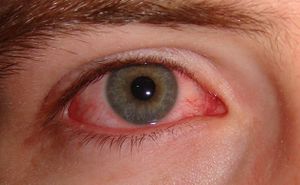We need you! Join our contributor community and become a WikEM editor through our open and transparent promotion process.
Conjunctivitis
From WikEM
Contents
Background
- Most common cause of acute red eye
- Viral infection is usual etiology
Conjunctivitis Types
Clinical Features
- Injected conjunctiva with perilimbal sparing
- Rarely painful; more irritated
Differential Diagnosis
Unilateral Red Eye
- Acute angle-closure glaucoma^
- Anterior uveitis
- Caustic keratoconjunctivitis^^
- Conjunctival laceration
- Conjunctivitis
- Corneal abrasion
- Corneal erosion
- Ocular foreign body
- Corneal ulcer^
- Endophthalmitis^
- Episcleritis
- Globe rupture^
- Herpes zoster ophthalmicus
- Intraocular foreign body
- Inflamed pingueculum
- Inflamed Pterygium
- Keratoconjunctivitis
- Keratoconus
- Lens dislocation
- Nontraumatic iritis
- Scleritis^
- Subconjunctival hemorrhage
- Traumatic hyphema
- Traumatic iritis
- Ultraviolet keratitis
^Emergent diagnoses
^^Critical diagnoses
Evaluation
- Typically clinical
Clinical diagnosis of conjunctivitis
| Bacterial | Viral | Allergic | |
|---|---|---|---|
| Bilateral | 50% | 25% | Mostly |
| Discharge | Mucopurulent | Clear, Watery | Cobblestoning, none |
| Redness | Yes | Yes | Yes |
| Pruritis | Rarely | Rarely | Yes |
| Additional | Treatment: Antibiotics | Treatment: Hygiene | Seasonal |
Management
- Viral infections - most common cause of conjunctivitis, but difficult to differentiate viral from bacterial
- Many clinicians treat all presentations as bacterial conjunctivitis
- Treatment considerations:
- Ointments - soothing effect, but interfere with vision
- Drops - no interference with vision
Antibiotics for Bacterial Causes
- Treatment for bacterial organisms is targeted toward S. aureus, S. pneumoniae, H. influenzae, Pseudomonas, N. gonorrhea, C. trachomatis
- Contact lens wearers should be given coverage for Pseudomonas with one of the fluoroquinolone drops.
- Contact lens wearers should be advised to not wear their contacts until asymptomatic
Bacterial Conjunctivitis
These options do not cover gonococcal or chlamydial infections
- Polymyxin B/Trimethoprim (Polytrim) 2 drops every 6 hours for 7 days OR
- Erythromycin applied to the conjunctiva q6hrs fir 7 days OR
- Levofloxacin 0.5% ophthalmic solution 1-2 drops every 2 hours for 2 days THEN every 6 hours for 5 days OR
- Moxifloxacin 0.5% ophthalmic 1-2 drops every 2 hours for 2 days THEN every 6 hours for 5 days OR
- Gatifloxacin 0.5% ophthalmic solution 1-2 drops every 2 hours for 2 days THEN 1 drop every 6 hours for 5 days OR
- Azithromycin 1% ophthalmic solution 1 drop BID for 2 days THEN 1 drop daily for 5 days
Chlamydial
- Doxycycline 100mg BID for 7 days OR
- Azithromycin 1g (20mg/kg) PO one time dose
- Newborn Treatment: Azithromycin 20mg/kg PO once daily x 3 days
- Disease manifests 5 days post-birth to 2 weeks (late onset)
Gonococcal
- Dual treatment for Chlamydia is recommended with azithromycin
- Ceftriaxone 1g IM one dose PLUS
- Azithromycin 1g PO one dose
- Newborn Treatment:
- Prophylaxis: Erythromycin ophthalmic 0.5% x1
- Disease manifests 1st 5 days post delivery (early onset)
- Treatment Ceftriaxone 25-50mg IV or IM, max 125mg
Contraindicated
- Corticosteroids have no benefit and can cause sight threatening injuries, especially in HSV or fungal causes of red eye
- Eye patching thought to exacerbate the infection
Disposition
- Outpatient treatment
See Also
References
- Mahmood, Narang. Diagnosis & management of acute red eye. Emerg Med Clin N Am 2008;26

